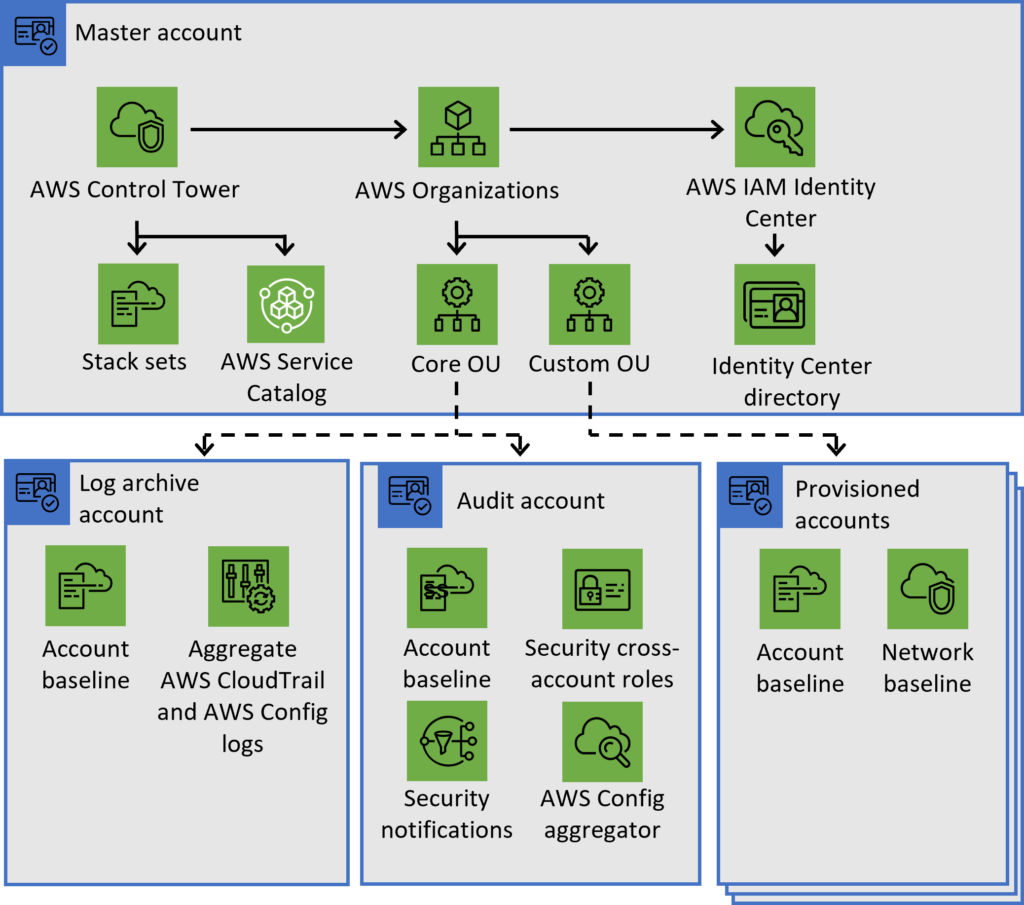Exploring AWS Landing Zone: Unleashing the Power of Security and Governance

Introduction
In my previous blog, we discussed the advantages of AWS Control Tower, which includes the convenience of its one-click Landing Zone setup. In this blog, we’ll take a closer look at AWS Landing Zone, a crucial part of Control Tower, and break down the important elements and information about its strong framework. With AWS Landing Zone, organizations can set up a secure, scalable, and multi-account AWS environment while following the best practices for security and governance.
What is AWS Landing Zone?
AWS Landing Zone is a well-architected framework designed to help organizations set up and manage a secure, scalable, and multi-account AWS environment. It serves as a foundational component within AWS Control Tower, enabling customers to accelerate the creation of new accounts while ensuring adherence to predefined security and governance policies. By leveraging AWS Control Tower, you can effortlessly establish a well-architected landing zone that aligns with your requirements.
AWS Landing Zone implements various blueprints to enhance the security and governance of your multi-account AWS environment. These blueprints include:
- Creating a multi-account environment using AWS Organizations enables efficient management and governance of your AWS resources across multiple accounts.
- Provisioning and standardizing new accounts using AWS Service Catalog ensures consistent configurations.
- Facilitation of federated access to accounts via AWS IAM Identity Center (Successor to AWS SSO), allowing secure and controlled access for different teams or stakeholders.
- Centralization of logging from AWS CloudTrail and AWS Config, which is stored in Amazon S3. This centralized approach simplifies log analysis, monitoring, and compliance activities.
- Enablement of security audits utilizing AWS IAM Identity Center (Successor to AWS SSO) and AWS IAM cross-account roles, providing comprehensive assessment and monitoring of your landing zone’s security posture.
In the past, setting up a landing zone could take weeks to months to complete. However, with AWS Control Tower, this process has been remarkably streamlined, reducing the setup time to less than an hour. This significant time reduction empowers you to establish a secure and well-governed landing zone quickly.
Why AWS Landing Zone?
AWS Customers engage in a variety of activities on the AWS platform, like running web applications, databases, machine learning or big data workloads, federating corporate identities, and many more. Before diving into design, development, and implementation efforts, it is crucial to have confidence in the operational scalability and security of their AWS footprint.
Typically, the responsibility for building a robust multi-account environment falls upon central IT or Cloud Teams. Constructing such an environment from scratch can be time-consuming and quickly become complicated as an organization grows. As more teams are added and more accounts are required, the need for standardization across each account and efficient management of IAM (Identity and Access Management) becomes critical.
By adopting AWS Landing Zone, organizations can save valuable time and effort by leveraging predefined best practices and standard processes for account provisioning, security policies, and IAM management.
AWS Landing Zone Architecture

AWS Landing Zone follows a well-defined architecture that consists of three foundational accounts: the Master (or Management) account, the Log Archive account, and the Audit account.
- Master Account: The Master account serves as the central point for managing the AWS Landing Zone environment. It hosts critical services such as AWS Organization for multi-account management, AWS IAM Identity Center (Successor of AWS SSO) for centralized identity and access management, and the Service Catalog for account provisioning. The Master account provides the necessary tools and resources to effectively manage and govern the entire Landing Zone infrastructure.
- Log Archive Account: The Log Archive account is responsible for centralizing the logs generated by the multiple AWS accounts in AWS Landing Zone managed environment. The Log Archive account primarily focuses on consolidating logs from AWS CloudTrail and AWS Config, providing a centralized location for comprehensive log analysis and compliance.
- Audit Account: The Audit account plays a crucial role in ensuring accountability, security, and compliance within the AWS Landing Zone environment. It serves as a dedicated account for cross-account access for the audit team, facilitating thorough inspections and evaluations. Additionally, the Audit account is responsible for receiving security notifications and acts as an AWS Config aggregator, collecting configuration data from other accounts for auditing and compliance purposes.
Benefits of AWS Landing Zone
- Simplified Account Provisioning: AWS Landing Zone provides a standardized process for creating new accounts, ensuring consistency and reducing the risk of mis-configuration.
- Enhanced Security and Governance: AWS Landing Zone empowers organizations to enforce baseline security policies, implement granular access controls, and leverage AWS-native services such as AWS CloudTrail, AWS Config, and AWS IAM Identity Center (Successor of AWS SSO) for identity and federation.
- Scalability and Agility: The architecture of AWS Landing Zone allows organizations to scale their infrastructure seamlessly. It provides a foundation that supports the rapid deployment of new accounts and resources, enabling organizations to adapt quickly to changing business needs.
- Resource Isolation and Separation of Duties: AWS Landing Zone ensures resource isolation, separation of duties, and clear billing separation by establishing a landing zone framework.
Wrap Up!
AWS Landing Zone, with its well-architected framework, provides organizations with a robust foundation for managing a secure, scalable, multi-account AWS environment. With Landing Zone Organizations can streamline their account management processes, centralize log analysis and compliance, and ensure accountability and security throughout their AWS infrastructure.
As the adoption of AWS Landing Zone solution grew, so did the complexity involved in managing and customizing the solution. Recognizing this challenge, AWS introduced AWS Control Tower, which simplifies the implementation and management of Landing Zone by providing a one-click setup and automated best practice enforcement. It offers a pre-configured landing zone with a set of guardrails and predefined security and governance policies, enabling organizations to accelerate their journey to a well-governed AWS environment. With AWS Control Tower, organizations can overcome the complexities associated with customizing and managing Landing Zone, while ensuring a secure and scalable multi-account AWS environment.